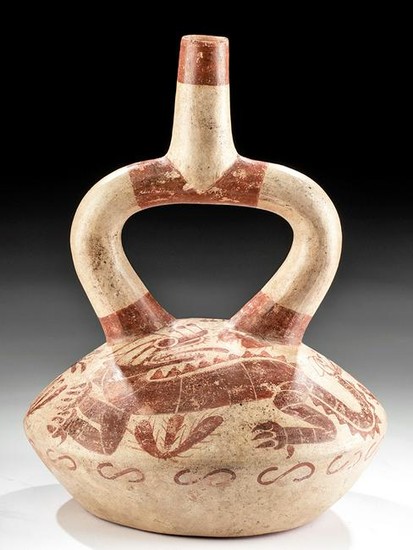Moche Fineline Stirrup Vessel - Strombus Monster
Pre-Columbian, Central/North Coast Peru, Moche, Phase V, ca. 600 to 800 CE. A fabulous example of a hand-built and highly burnished pottery vessel with a planar base, a compressed circular body with a protruding central carination, a rounded top, a stirrup-shaped handle with inward-bent arms, and a tapered conical spout on top. The cream-slipped vessel composition is accentuated with solid rings of red-brown slip on the base and top of the handle as well as the spout tip, and a register of repeating lemniscate forms course around the lower body just beneath the carination. Illustrated on the top are two instances of the "Strombus Monster," a terrifying chimeric beast with a striated, feline-form body with serrated back scales, a gaping mouth with sharp teeth and a protruding tongue, and a tail bearing a secondary serpentine head. The monsters are presented with each head gazing to the right, and spiny cacti fill the areas around and beneath the bodies. Size: 6.125" W x 8.1" H (15.6 cm x 20.6 cm)
While there are many fantastical beasts in the bestiary of ancient Moche artistry, none is more intriguing than the Strombus Monster - an amalgam beast that synthesizes characteristics from the sea-dwelling conch shell (Strombus galeatus) and the land snail they were more accustomed to. According to authors Christopher B. Donnan and Donna McClelland, "The Strombus Monster is introduced in Phase IV and is very frequently portrayed. It combines a Strombus shell, a large-eared serpent head, a feline body with claws and pelage markings, and a tail ending in a small-eared serpent head. On its snout are antennae similar to those found on land snails." (Donnan, Christopher B. and Donna McClelland. "Moche Fineline Painting: Its Evolution and Its Artists." UCLA Fowler Museum of Cultural History, Los Angeles, California, 1999, p. 116)
For another example of the Strombus Monster depicted in the fineline technique on a Phase IV stirrup vessel, please see: Donnan, Christopher B. and Donna McClelland. "Moche Fineline Painting: Its Evolution and Its Artists." UCLA Fowler Museum of Cultural History, Los Angeles, California, 1999, p. 87, fig. 4.25.
Provenance: ex-Sloans & Kenyon Auctions, Chevy Chase, Maryland, USA, 1998
All items legal to buy/sell under U.S. Statute covering cultural patrimony Code 2600, CHAPTER 14, and are guaranteed to be as described or your money back.
A Certificate of Authenticity will accompany all winning bids.
We ship worldwide to most countries and handle all shipping in-house for your convenience.
#153219 Dimensions: Condition Report: Minor nicks and abrasions to base, body, handle, and spout, with fading to original pigmentation and areas of touch-up painting, and light encrustations, otherwise intact and excellent. Light earthen deposits and manganese deposits throughout, and great traces of original pigment in some areas.
View it on
Estimate
Time, Location
Auction House
Pre-Columbian, Central/North Coast Peru, Moche, Phase V, ca. 600 to 800 CE. A fabulous example of a hand-built and highly burnished pottery vessel with a planar base, a compressed circular body with a protruding central carination, a rounded top, a stirrup-shaped handle with inward-bent arms, and a tapered conical spout on top. The cream-slipped vessel composition is accentuated with solid rings of red-brown slip on the base and top of the handle as well as the spout tip, and a register of repeating lemniscate forms course around the lower body just beneath the carination. Illustrated on the top are two instances of the "Strombus Monster," a terrifying chimeric beast with a striated, feline-form body with serrated back scales, a gaping mouth with sharp teeth and a protruding tongue, and a tail bearing a secondary serpentine head. The monsters are presented with each head gazing to the right, and spiny cacti fill the areas around and beneath the bodies. Size: 6.125" W x 8.1" H (15.6 cm x 20.6 cm)
While there are many fantastical beasts in the bestiary of ancient Moche artistry, none is more intriguing than the Strombus Monster - an amalgam beast that synthesizes characteristics from the sea-dwelling conch shell (Strombus galeatus) and the land snail they were more accustomed to. According to authors Christopher B. Donnan and Donna McClelland, "The Strombus Monster is introduced in Phase IV and is very frequently portrayed. It combines a Strombus shell, a large-eared serpent head, a feline body with claws and pelage markings, and a tail ending in a small-eared serpent head. On its snout are antennae similar to those found on land snails." (Donnan, Christopher B. and Donna McClelland. "Moche Fineline Painting: Its Evolution and Its Artists." UCLA Fowler Museum of Cultural History, Los Angeles, California, 1999, p. 116)
For another example of the Strombus Monster depicted in the fineline technique on a Phase IV stirrup vessel, please see: Donnan, Christopher B. and Donna McClelland. "Moche Fineline Painting: Its Evolution and Its Artists." UCLA Fowler Museum of Cultural History, Los Angeles, California, 1999, p. 87, fig. 4.25.
Provenance: ex-Sloans & Kenyon Auctions, Chevy Chase, Maryland, USA, 1998
All items legal to buy/sell under U.S. Statute covering cultural patrimony Code 2600, CHAPTER 14, and are guaranteed to be as described or your money back.
A Certificate of Authenticity will accompany all winning bids.
We ship worldwide to most countries and handle all shipping in-house for your convenience.
#153219 Dimensions: Condition Report: Minor nicks and abrasions to base, body, handle, and spout, with fading to original pigmentation and areas of touch-up painting, and light encrustations, otherwise intact and excellent. Light earthen deposits and manganese deposits throughout, and great traces of original pigment in some areas.



